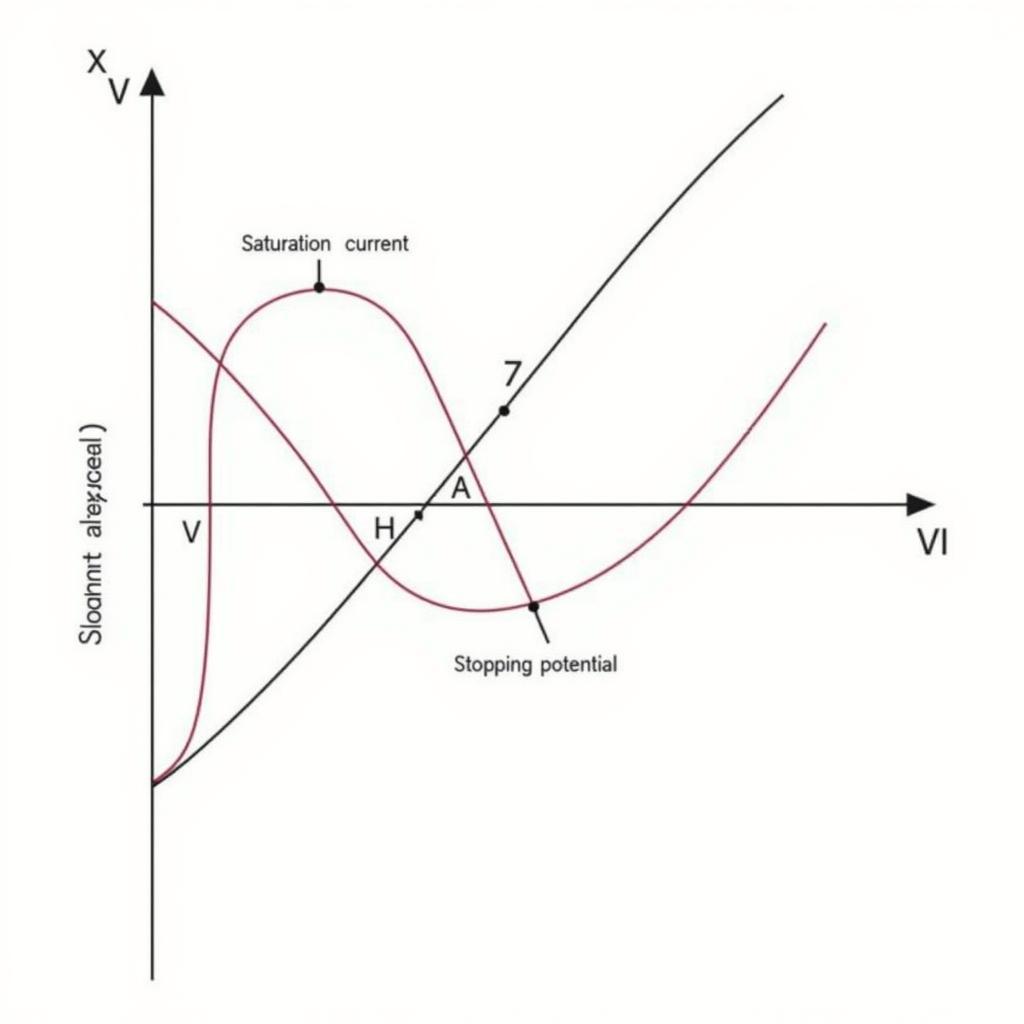The current vs. voltage graph in the photoelectric effect is crucial to understanding this fascinating phenomenon. It visually represents the relationship between the photocurrent (the current generated by emitted photoelectrons) and the potential difference applied across the emitting material and the collector. This graph unlocks key insights into the nature of light and matter interaction.
Decoding the Current vs. Voltage Graph
The current vs. voltage graph provides a visual representation of the photoelectric effect. The x-axis represents the applied voltage, while the y-axis represents the photocurrent. Analyzing this graph reveals crucial information about the photoelectric effect.
Key Features of the Graph
-
Saturation Current: Even with increasing positive voltage, the current reaches a maximum value called the saturation current. This indicates that all emitted photoelectrons are reaching the collector. The saturation current is directly proportional to the intensity of the incident light. More intense light means more photons, which leads to more emitted photoelectrons and a higher saturation current.
-
Stopping Potential: Applying a negative voltage to the collector repels the emitted electrons. The stopping potential (Vs) is the minimum negative voltage required to stop even the most energetic photoelectrons from reaching the collector, effectively reducing the photocurrent to zero. The stopping potential is independent of the intensity of the incident light but directly related to the frequency of the incident light.
-
Effect of Light Intensity: Increasing the intensity of the incident light increases the number of emitted photoelectrons, directly affecting the saturation current. However, it doesn’t change the stopping potential. This confirms that the kinetic energy of the emitted electrons is independent of the light intensity.
 Current vs. Voltage Graph in the Photoelectric Effect
Current vs. Voltage Graph in the Photoelectric Effect
The Significance of Stopping Potential
The stopping potential (Vs) is a critical parameter in the photoelectric effect. It provides a direct measure of the maximum kinetic energy of the emitted photoelectrons. This relationship is expressed by the equation: KEmax = eVs, where ‘e’ is the elementary charge. By measuring Vs, we can determine the maximum kinetic energy of the emitted electrons and gain valuable insights into the nature of the photoelectric effect.
Impact of Frequency
The stopping potential is directly proportional to the frequency of the incident light. Higher frequency light leads to a larger stopping potential, indicating that the emitted electrons have greater kinetic energy. This crucial observation supports Einstein’s explanation of the photoelectric effect, which posits that light energy is quantized into photons.
Applications of the Photoelectric Effect
Understanding the Current Vs Voltage Graph Photoelectric Effect has led to various practical applications.
-
Photodiodes: These devices utilize the photoelectric effect to convert light into electrical signals, enabling light detection in various applications, such as cameras, solar cells, and optical communication systems.
-
Photomultipliers: These highly sensitive detectors amplify the photocurrent, allowing for the detection of even very weak light signals, used in scientific research and medical imaging.
-
Solar Panels: These devices utilize the photoelectric effect to generate electricity from sunlight, providing a renewable energy source.
Conclusion
The current vs. voltage graph in the photoelectric effect is essential for understanding the relationship between light and matter. By analyzing this graph, we can determine key parameters such as saturation current and stopping potential, providing insights into the nature of light and its interaction with matter. This understanding has led to numerous practical applications, from photodiodes and photomultipliers to solar panels, showcasing the significance of the photoelectric effect in modern technology. Remember the current vs voltage graph photoelectric effect is a cornerstone of modern physics and continues to drive technological advancements.
FAQ
- What is the significance of the saturation current?
- How does the intensity of light affect the photoelectric effect?
- What is the relationship between stopping potential and frequency?
- How is the photoelectric effect used in solar panels?
- What is the equation relating stopping potential and maximum kinetic energy?
- Why does increasing the frequency increase the stopping potential?
- What are some other applications of the photoelectric effect besides solar panels?
Khi cần hỗ trợ hãy liên hệ Số Điện Thoại: 02838172459, Email: truyenthongbongda@gmail.com Hoặc đến địa chỉ: 596 Đ. Hậu Giang, P.12, Quận 6, Hồ Chí Minh 70000, Việt Nam. Chúng tôi có đội ngũ chăm sóc khách hàng 24/7.